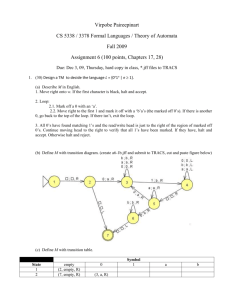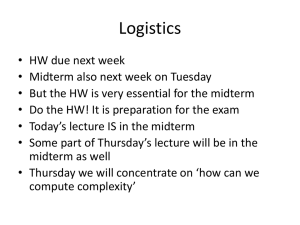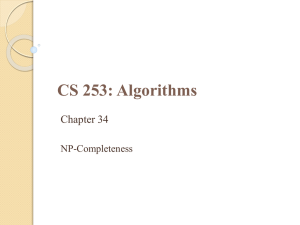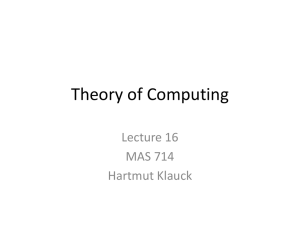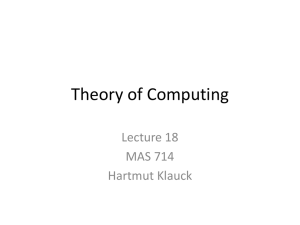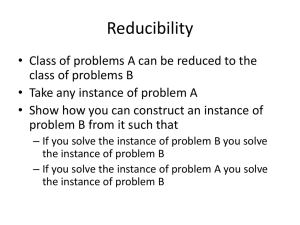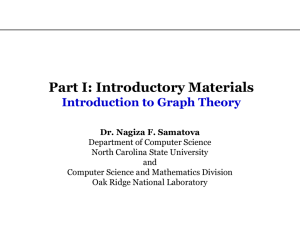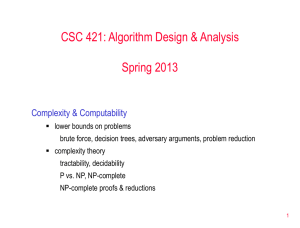May 28 (Lecture 5)
advertisement
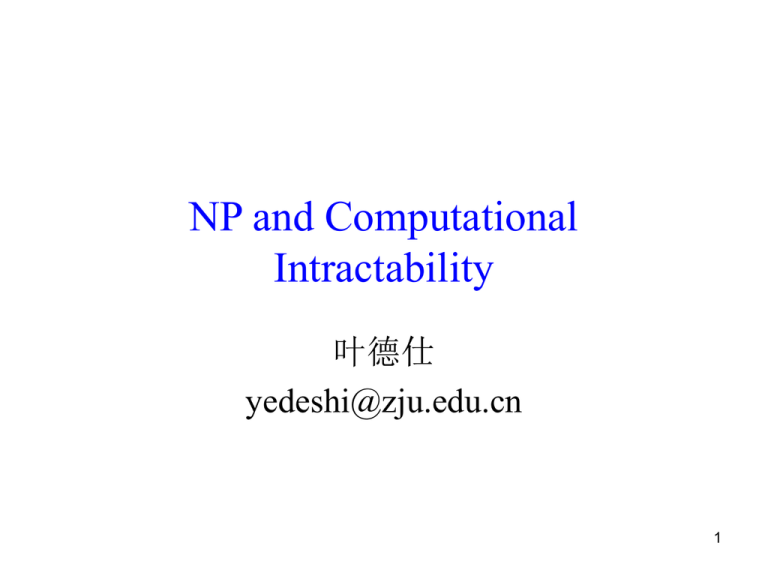
NP and Computational
Intractability
叶德仕
yedeshi@zju.edu.cn
1
Decision Problems
Decision problem. (the answer is simply "yes"
or "no" )
X is a set of strings.
Instance: string s.
Algorithm A solves problem X: A(s) = yes iff s ∈ X.
Optimization problems. in which each feasible
(i.e., "legal") solution has an associated value,
and we wish to find the feasible solution with
the best value.
2
Polynomial time. Algorithm A runs in poly-time if for
every string s, A(s) terminates in at most p(|s|) "steps",
where p(.) is some polynomial.
Certification algorithm intuition.
Certifier views things from "managerial" viewpoint.
Certifier doesn't determine whether s ∈ X on its own;
rather, it checks a proposed certificate t that s ∈ X.
i.e., certifier verify the proposed solution t and the
instance s whether C(s,t) is yes.
3
Def. Algorithm C(s, t) is a certifier for problem
X if for every string s, s ∈ X iff there exists a
string t such that C(s, t) = yes.
NP. Decision problems for which there
exists a poly-time certifier.
Remark. NP stands for nondeterministic
poly-time.
4
Certifiers and Certificates:
Composite (合数)
COMPOSITES. Given an integer s, is s composite?
Certificate. A nontrivial factor t of s. Note that such a
certificate exists iff s is composite. Moreover |t| ≤ |s|.
Certifier.
boolean C(s, t) {
if (t ≤1 or t ≥ s)
return false
else if (s is a multiple of t)
return true
else
return false
}
5
Example
Instance. s = 437,669.
Certificate. t = 541 or 809.
Conclusion. COMPOSITES is in NP.
6
Certifiers and Certificates:
3-Satisfiability
SAT. Given a CNF formula , is there a
satisfying assignment?
Certificate. An assignment of truth values to the n
boolean variables.
Certifier. Check that each clause in has at
least one true literal.
Instance:
( x1 x2 x3 ) ( x1 x2 x3 ) ( x1 x2 x4 ) ( x1 x3 x4 )
Certificate:
x1 1, x2 1, x3 0, x4 1
Conclusion. SAT is in NP.
7
Certifiers and Certificates:
Hamiltonian Cycle
HAM-CYCLE. Given an undirected graph G = (V, E),
does there exist a simple cycle C that visits every node?
Certificate. A permutation of the n nodes.
Certifier. Check that the permutation contains each node
in V exactly once, and that there is an edge between
each pair of adjacent nodes in the permutation.
Conclusion. HAM-CYCLE is in NP.
8
Halting problem
The halting problem is a decision problem
which can be stated as follows:
given a description of a program and a finite
input, decide whether the program finishes
running or will run forever, given that input.
The halting problem is undecidable. (Alan
Turing 1936)
9
P, NP, EXP
P. Decision problems for which there is a
poly-time algorithm.
EXP. Decision problems for which there is
an exponential-time algorithm.
NP. Decision problems for which there is a
poly-time certifier.
10
Claim.
P NP
Pf. Consider any problem X in P. By definition, there
exists a poly-time algorithm A(s) that solves X.
Certificate: certifier C(s, t) = A(s).
Claim. NP EXP
Pf. Consider any problem X in NP.
By definition, there exists a poly-time certifier C(s, t)
for X. To solve input s, run C(s, t) on all strings t with
|t| ≤ p(|s|).
Return yes, if C(s, t) returns yes for any of these. !
11
The Main Question:
P Versus NP
Does P = NP? [Cook 1971, Edmonds, Levin,
Yablonski, Gödel]
Is the decision problem as easy as the
certification problem?
Clay $1 million prize.
EXP
EXP
P
P = NP
NP
If P = NP
If P ≠ NP
12
A formual-language
Framework
An alphabet Σ is a finite set of symbols.
A language L over Σ is any set of strings made up of
symbols from Σ.
For example,
Σ = {0, 1},
L = {10, 11, 101, 111, 1011, 1101, 10001,...}
L is the language of binary representations of prime
numbers
Denote empty string by ε
Denote empty language by Ø
13
The language of all strings over Σ is denoted
Σ*.
For example
Σ = {0, 1},
then Σ* = {ε, 0, 1, 00, 01, 10, 11, 000,...} is the
set of all binary strings.
Every language L over Σ is a subset of Σ*.
14
Set-theoretic
operations
complement of L by Σ*- L.
The concatenation of two languages L1 and
L2 is the language
L = {x1x2 : x1 ∈ L1 and x2 ∈ L2}.
The closure or Kleene star of a language L is
the language
L*= {ε} ∪ L ∪ L2 ∪ L3 ∪ ···,
where Lk is the language obtained by
concatenating L to itself k times.
15
Decision problem
and language
the set of instances for any decision problem Q is
simply the set Σ*, where Σ = {0, 1}.
Since Q is entirely characterized by those problem
instances that produce a 1 (yes) answer, we can view
Q as a language L over Σ = {0, 1}, where
L = {x ∈ Σ*: Q(x) = 1}.
Example:
PATH = {〈G, u, v, k〉 : G = (V, E) is an undirected
graph, u, v ∈ V, k ≥ 0 is an integer, and there exists a
path from u to v in G consisting of at most k edges}.
16
We say that an algorithm A accepts a string x ∈
{0, 1}* if, given input x, the algorithm's output
A(x) is 1.
The language accepted by an algorithm A is
the set of strings L = {x ∈ {0, 1}*: A(x) = 1}
An algorithm A rejects a string x if A(x) = 0.
A language L is decided by an algorithm A if
every binary string in L is accepted by A and
every binary string not in L is rejected by A.
17
A language L is accepted in polynomial time by an
algorithm A if it is accepted by A and if in addition there is a
constant k such that for any length-n string x ∈ L, algorithm
A accepts x in time O(nk).
A language L is decided in polynomial time by an algorithm
A if there is a constant k such that for any length-n string x ∈
{0, 1}*, the algorithm correctly decides whether x ∈ L in
time O(nk).
To accept a language, an algorithm need only worry about
strings in L, but to decide a language, it must correctly
accept or reject every string in {0, 1}*.
18
Class P
P = {L ⊆ {0, 1}* : there exists an algorithm A
that decides L in polynomial time}
19
Polynomial-time
verification
For example, suppose that for a given instance
〈G, u, v, k〉 of the decision problem PATH,
We are also given a path p from u to v.
We can easily check whether the length of p is
at most k.
So, we can view p as a "certificate" that the
instance indeed belongs to PATH.
20
Verification algorithms
define a verification algorithm as being a twoargument algorithm A, where one argument is an
ordinary input string x and the other is a binary string
y called a certificate.
A two-argument algorithm A verifies an input string x
if there exists a certificate y such that A(x, y) = 1.
The language verified by a verification algorithm A
is L = {x ∈ {0, 1}* : there exists y ∈ {0, 1}* such
that A(x, y) = 1}.
21
Class NP
The complexity class NP is the class of languages that
can be verified by a polynomial-time algorithm
More precisely, a language L belongs to NP if and
only if there exist a two-input polynomial-time
algorithm A and constant c such that
L = {x ∈ {0, 1}* : there exists a certificate y with |y| =
O(|x|c) such that A(x, y) = 1}.
We say that algorithm A verifies language L in
polynomial time.
22
class co-NP
That is, does L ∈ NP imply L NP ?
We can define the complexity class co-NP as
the set of languages L such that L NP
NP=co-NP
P=NP=co-NP
P
co-NP
P=NP∩ co-NP
NP
co-NP
NP∩ co-NP
P
NP
23
NP-completeness
and reducibility
Polynomial Transformation
Def. Problem X polynomial reduces (Cook) to
problem Y if arbitrary instances of problem X can be
solved using:
Polynomial number of standard computational steps, plus
Polynomial number of calls to oracle that solves problem Y.
Def. Problem X polynomial transforms (Karp) to
problem Y if given any
For any input x to X, we can construct an input y in
polynomial time such that x is a yes instance of X iff y is a
yes instance of Y.
24
we say that a language L1 is polynomial-time
reducible to a language L2
written L1 ≤P L2 ,
if there exists a polynomial-time computable
function f : {0, 1}* → {0,1}* such that for all x
{0, 1}*,
x L1 if and only if f ( x) L2
We call the function f the reduction function,
and a polynomial-time algorithm F that
computes f is called a reduction algorithm.
25
NP-Complete
NP-complete. A problem Y in NP with the
property that for every problem X in NP, X ≤P Y.
A language L ⊆ {0, 1}* is NP-complete if
L ∈ NP, and
L′ ≤P L for every L∈ NP.
26
Lemma. If L1, L2 ⊆ {0,1}* are languages such
that L1 ≤P L2, then L2 ∈ P implies L1 ∈ P.
yes, f ( x) L2
yes, x L1
f (x)
x
F
A2
A1
no, f ( x) L2
no, x L2
27
Theorem. If any NP-complete problem is
polynomial-time solvable, then P = NP.
Pf. Suppose that L ∈ P and also that L ∈ NPC.
For any L′ ∈ NP, we have L′ ≤P L by property 2
of the definition of NP-completeness. Thus, by
above Lemma , we also have that L′ ∈ P, which
proves the theorem.
NP
P
NPC
If P ≠ NP
28
Circuit Satisfiability
CIRCUIT-SAT. Given a combinational circuit
built out of AND, OR, and NOT gates, is there
a way to set the circuit inputs so that the output
is 1?
Output
Yes: 101
1
0
?
?
?
29
The "First"
NP-Complete Problem
Circuit-SAT:
given a boolean combinatorial circuit composed of
AND, OR, and NOT gates, is it satisfiable?
Theorem. CIRCUIT-SAT is NP-complete. [Cook
1971, Levin 1973]
Pf.
The circuit-satisfiability problem belongs to the class
NP.
show that every language in NP is polynomial-time
reducible to CIRCUIT-SAT.
30
Establishing NP-Completeness
Method for showing that a problem Y is NPcomplete
Show that Y is in NP.
Choose an NP-complete problem X.
X ≤P Y
Justification. If X is a problem such that
Y ≤P X for some Y ∈ NPC, then X is NP-hard.
Moreover, if X ∈ NP, then L ∈ NPC.
31
3-CNF satisfiability
A boolean formula is in conjunctive normal
form, or CNF, if it is expressed as an AND of
clauses, each of which is the OR of one or
more literals.
3-CNF, if each clause has exactly three
distinct literals.
Example:
(x1 ∨ ¬x1 ∨ ¬x2) ∧ (x3 ∨ x2 ∨ x4) ∧ (¬x1 ∨ ¬x3 ∨
¬x4)
32
3-SAT is NP-Complete
Theorem. 3-SAT is NP-complete.
PfS. Suffices to show that CIRCUIT-SAT ≤P
3-SAT since 3-SAT is in NP.
33
The clique problem
A clique in an undirected graph G = (V, E) is a subset
V' ⊆ V of vertices, each pair of which is connected by
an edge in E.
In other words, a clique is a complete subgraph of G. The
size of a clique is the number of vertices it contains.
The clique problem is the optimization problem of
finding a clique of maximum size in a graph.
As a decision problem, we ask simply whether a clique
of a given size k exists in the graph. The formal
definition is
CLIQUE = {〈G, k〉 : G is a graph with a clique of
size k}.
34
Clique problem
Theorem. The clique problem is NP-complete.
Pf. CLIQUE is in NP,
for a given graph G = (V, E), we use the set V' ⊆ V of vertices in the
clique as a certificate for G. Checking whether V' is a clique can be
accomplished in polynomial time by checking whether, for each pair u,
v ∈ V', the edge (u, v) belongs to E.
next prove that 3-CNF-SAT ≤P CLIQUE
reduction algorithm:
Let φ = C1 ∧ C2 ∧ ··· ∧ Ck be a boolean formula in 3-CNF
with k clauses.
We shall construct a graph G such that φ is satisfiable
if and only if G has a clique of size k.
35
Construct of graph G
The graph G = (V, E) is constructed as follows.
For each clause Cr=(r1, r2, r3), we place a triple
of vertices vr1, vr2, vr3 in V.
We put an edge between two vertices vri, vsj if both
of the following hold:
vri and vsj are in different triples, that is, r ≠ s,
their corresponding literals are consistent, that is
ri is not the negation of sj.
This graph can easily be computed from φ in
polynomial time
36
Example
φ = (x1 ∨ ¬x2 ∨ ¬x3) ∧ (¬x1 ∨ x2 ∨ x3) ∧ (x1 ∨ x2
∨ x3),
37
Proof. Con.
We must show that this transformation of φ
into G is a reduction
First, suppose that φ has a satisfying assignment. Then each
clause Cr contains at least one literal rj that is assigned 1. and
each such literal corresponds to a vertex vrj. Picking one such
"true" literal from each clause yields a set V' of k vertices. We
claim that V' is a clique.
For any two vertices vri, vsj where r ≠ s, both corresponding
literals ri rand sj are mapped to 1 by the given satisfying
assignment, and thus the literals cannot be complements.
38
Proof. Con.
Conversely, suppose that G has a clique V' of
size k.
No edges in G connect vertices in the same triple, and so V'
contains exactly one vertex per triple.
We can assign 1 to each literal ri such that vrj ∈V' , then
assigning 1 to both a literal and its complement can not happen,
since G contains no edges between inconsistent literals.
Each clause is satisfied, and so φ is satisfied
Any variables that do not correspond to a vertex in the clique
may be set arbitrarily
39
The vertex-cover problem
A vertex cover of an undirected graph G = (V, E)
is a subset V' ⊆ V such that if (u, v) ∈ E, then u
∈ V' or v ∈ V' (or both).
A vertex cover for G is a set of vertices that
covers all the edges in E.
As a decision problem, we define
VERTEX-COVER = {〈G, k〉 : graph G has a
vertex cover of size k}.
40
Vertex-cover is NPC
Theorem. The vertex-cover problem is NPcomplete.
We first show that VERTEX-COVER ∈ NP. Given
a graph G = (V, E) and an integer k.
Certificate is the vertex cover V' ⊆ V itself.
The verification algorithm affirms that |V'| = k, and
then it checks, for each edge (u, v) ∈ E, that u ∈ V'
or v ∈ V'.
This verification can be performed
straightforwardly in polynomial time.
41
The vertex-cover problem is NP-hard by
showing that CLIQUE ≤P VERTEX-COVER
This reduction is based on the notion of the
"complement" of a graph.
Given an undirected graph G = (V, E), we define
the complement of G, the graph containing
exactly those edges that are not in G.
42
Example:
complement of G
43
Vertex-cover
The reduction algorithm takes as input an
instance 〈G, k〉 of the clique problem . It
computes the complement G , which is easily
done in polynomial time.
The output of the reduction algorithm is the
instance G,| V | k of the vertex-cover problem.
The graph G has a clique of size k if and only
if the graph G has a vertex cover of size |V | - k.
44
Vertex-cover
Suppose that G has a clique V' ⊆ V with |V'| = k .
We claim that V - V' is a vertex cover in .G
Let (u, v) be any edge in Ē. Then, (u, v) ∉ E,
which implies that at least one of u or v does
not belong to V', since every pair of vertices in
V' is connected by an edge of E. Equivalently,
at least one of u or v is in V - V‘, which means
that edge (u, v) is covered by V - V'.
Hence, the set V - V', which has size |V | - k,
forms a vertex cover for G
45
Vertex-cover con.
Conversely, suppose that G has a vertex cover
V' ⊆ V , where |V'| = |V| - k.
Then, for all u, v ∈ V, if (u, v) ∈ Ē, then u ∈ V'
or v ∈ V' or both.
For all u, v ∈ V, if u ∉ V' and v ∉ V', then (u, v)
∈ E. In other word, V -V' is a clique, and it has
size |V |-|V'| = k.
46
Hamiltonian Cycle
HAM-CYCLE: given an undirected graph G =
(V, E), does there exist a simple cycle that
contains every node in V.
47
YES: vertices and faces of a dodecahedron.
Hamiltonian Cycle
HAM-CYCLE: given an undirected graph G =
(V, E), does there exist a simple cycle that
contains every node in V.
NO: bipartite graph with odd number of nodes..
48
Directed
Hamiltonian Cycle
DIR-HAM-CYCLE: given a digraph G = (V,
E), does there exists a simple directed
cycle that contains every node in V?
Claim. DIR-HAM-CYCLE ≤P HAM-CYCLE.
V
Vin
Vout
V
49
3-SAT Reduces to
Directed Hamiltonian Cycle
Claim. 3-SAT ≤P DIR-HAM-CYCLE
50
3-SAT Reduces to
Directed Hamiltonian Cycle
Claim. 3-SAT ≤P DIR-HAM-CYCLE
Pf. Given an instance of 3-SAT, we construct
an instance of DIRHAM-CYCLE that has a
Hamiltonian cycle iff is satisfiable.
Construction. First, create graph that has 2n
Hamiltonian cycles which correspond in a
natural way to 2n possible truth assignments.
Intuition: traverse path i from left to right
iff set variable xi = 1.
51
Hamiltonian Path
HAM-CYCLE ≤p HAM-PATH:
52
Longest Path
SHORTEST-PATH. Given a digraph G = (V,
E), does there exists a simple path of
length at most k edges?
LONGEST-PATH. Given a digraph G = (V,
E), does there exists a simple path of
length at least k edges?
53
Longest Path
Claim. HAM-CYCLE ≤p Longest-Path
Let G=(V,E) be an instance of HAM-CYCLE.
If the longest-simple-cycle in G is of length |V|, then every
vertex was visited and thus there is a Hamiltonian cycle in G.
Reduction:
Compute the longest-simple-cycle in G.
If the length of this cycle=|V|,
There is a Hamiltonian cycle.
Else, there is no Hamiltonian cycle.
54
The longest path
I have been hard working for so long.
I swear it's right, and he marks it wrong.
Woh-oh-oh-oh, find the longest path!
Some how I'll feel sorry when it's done:
Woh-oh-oh-oh, find the longest path!
GPA 2.1
If you said P is NP tonight,
Is more than I hope for.
There would still be papers left to write,
Garey, Johnson, Karp and other men
I have a weakness,
(and women)
I'm addicted to completeness,
Tried to make it order N log N.
And I keep searching for the longest path.
Am I a mad fool
The algorithm I would like to see
If I spend my life in grad school,
Is of polynomial degree,
Forever following the longest path?
But it's elusive:
Woh-oh-oh-oh, find the longest path!
Nobody has found conclusive
Woh-oh-oh-oh, find the longest path!
Evidence that we can find a longest path.
Woh-oh-oh-oh, find the longest path.
Lyrics. Copyright © 1988 by Daniel J. Barrett.
Music. Sung to the tune of The Longest time by Billy Joel.
Recorded by Dan Barrett while a grad student at Johns Hopkins during
a difficult algorithms final.
55
The traveling-salesman
problem (TSP)
Traveling-salesman problem:
A salesman spends his time visiting n cities (or
nodes) cyclically. In one tour he visits each
city just once, and finishes up where he started.
In what order should he visit them to minimise
the distance travelled?
There is an integer cost c(i, j) to travel from
city i to city j,
56
TSP: NPC
Theorem. The traveling-salesman problem is
NP-complete.
Pf. HAM-CYCLE ≤P TSP.
Let G = (V, E) be an instance of HAM-CYCLE.
We construct an instance of TSP as follows.
We form the complete graph G' = (V, E'),
where E' = {(i, j) : i, j ∈ V and i ≠ j}, and we
define the cost function c by
0 if (i, j ) E
C (i, j )
1 else
57
Proof.
graph G has a hamiltonian cycle if and only if graph
G' has a tour of cost at most 0.
Suppose that graph G has a hamiltonian cycle h. Each
edge in h belongs to E and thus has cost 0 in G'. Thus,
h is a tour in G' with cost 0
Conversely, suppose that graph G' has a tour h' of cost
at most 0. Since the costs of the edges in E' are 0 and
1, the cost of tour h' is exactly 0 and each edge on the
tour must have cost 0.
Therefore, h' contains only edges in E. We conclude
that h' is a hamiltonian cycle in graph G.
58
NP Problems
59
Subset sum problem
Given a set of integers and an integer s, does
any non-empty subset sum to s?
60
Partition Problem
Given a set S of integers, is there a way to
partition S into two subsets S1 and S2 such that
the sum of the numbers in S1 equals the sum of
the numbers in S2?
The subsets S1 and S2 must form a partition in
the sense that they are disjoint and they cover
S.
61
3-Partition problem
A variation of the partition problem is the 3partition problem, in which the set S must be
partitioned into |S|/3 triples each with the same
sum.
62
Exercise
Prove that the Knapsack problem is NP-hard
Prove that the Bin packing problem is NP-hard
63
A compendium of
NP optimization problems
Editors:
Pierluigi Crescenzi, and Viggo Kann
Subeditors:
Magnús Halldórsson (retired)
Graph Theory: Covering and Partitioning, Subgraphs
and Supergraphs, Sets and Partitions.
Marek Karpinski
Graph Theory: Vertex Ordering, Network Design:
Cuts and Connectivity.
Gerhard Woeginger
Sequencing and Scheduling.
http://www.nada.kth.se/~viggo/problemlist/
64
The NP-Completeness Column
David Johnson. ACM TRANSACTIONS ON
ALGORITHMS 1:1, 160-176 (2005)
65
Open Problem
Open: the Visibility Graph Recognition problem is not even
known to be in NP.
Visibility Graph Recognition problem: Given a visibility graph
G and a Hamiltonian circuit C, determine in polynomial time
whether there is a simple polygon whose vertex visibility graph
is G, and whose boundary corresponds to C.
Visibility Graph: Let S be a set of simple polygonal obstacles
in the plane, then the nodes of the visibility graph of are just
the vertices of S, and there is an edge (called a visibility edge)
between vertices and if these vertices are mutually visible.
A simple polygon is a polygon which does not intersect itself
anywhere. These are also called Jordan polygons.
66

